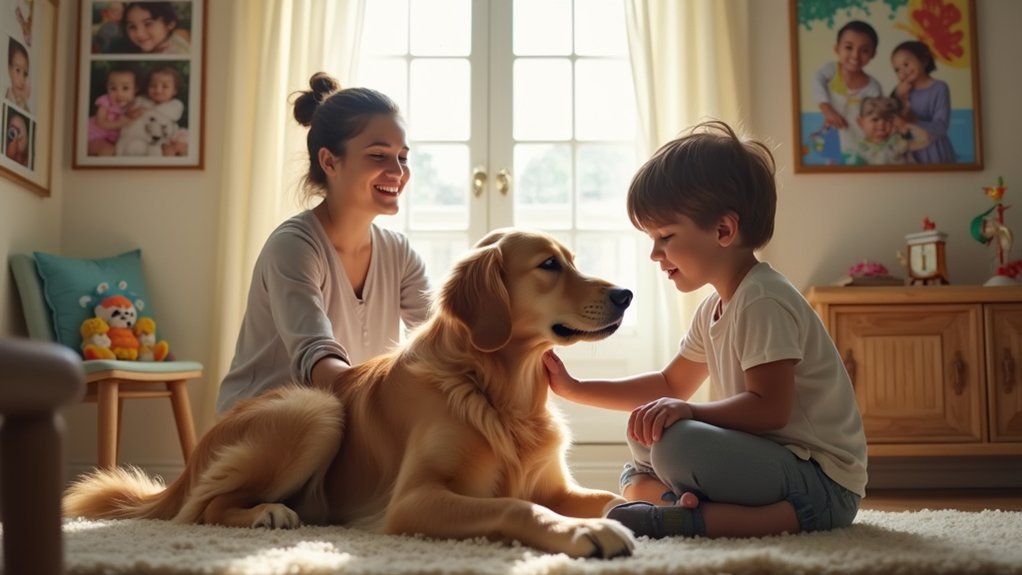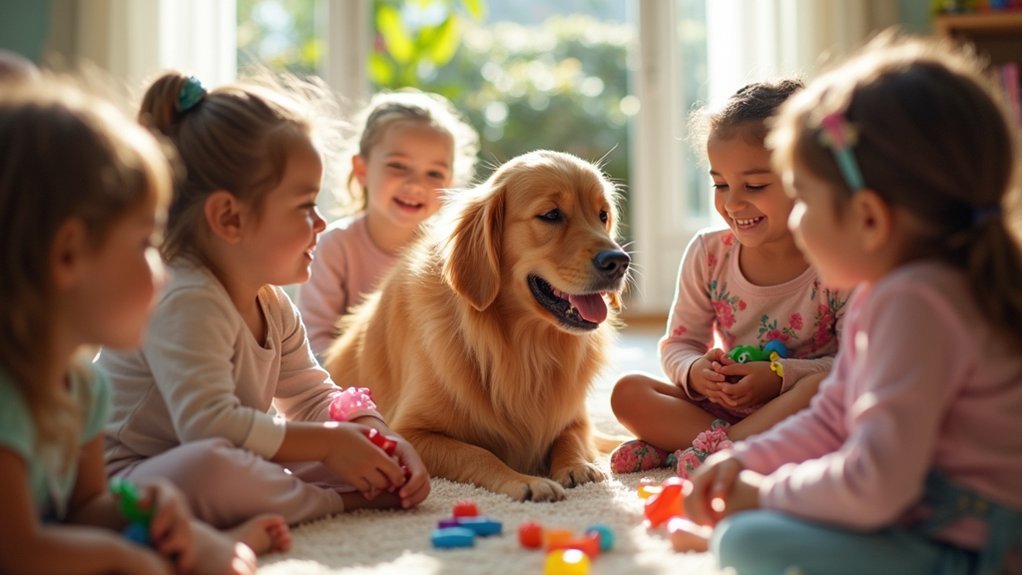Animal therapy creates a non-threatening bridge that helps develop social skills naturally. When you interact with therapy animals, they reduce your anxiety and provide immediate feedback on non-verbal cues. These furry companions serve as conversation starters, encouraging communication without judgment. Children with autism often show remarkable improvements in eye contact and verbal expression during these interventions. Therapy animals build trust and emotional safety that transfers to human relationships, opening doors to meaningful connections you might not discover otherwise.
The Science Behind Animal-Human Connection in Therapy

The fascinating science behind animal-human connection in therapy reveals a complex interplay of evolutionary, neurological, and psychological factors.
When you interact with a therapy animal, particularly a dog, you’re engaging with a species that has evolved specifically to read human emotions and respond to social cues.
Therapy dogs offer a unique evolutionary gift—the ability to interpret and respond to our emotional state with remarkable accuracy.
This connection isn’t merely emotional—it triggers neurological responses that reduce stress and anxiety while promoting emotional regulation.
The bond you form resembles parent-child attachments, creating a foundation of unconditional acceptance and reciprocity. This attachment becomes a powerful social catalyst, helping you communicate more effectively in a comfortable environment.
Research measures these bonds using specialized scales, confirming what many experience intuitively: animals create a unique therapeutic context that encourages emotional expression and openness unmatched by traditional therapies alone.
Studies supported by HABRI have demonstrated that animal-assisted interventions show promising results for those with autism spectrum disorder, helping to improve social interaction skills in therapeutic settings.
Breaking Social Barriers With Four-Legged Companions
You’ll notice how therapy animals serve as natural “ice-breakers,” creating instant connections in situations where social interaction might otherwise feel overwhelming.
These furry friendship facilitators help dissolve barriers by providing a non-threatening common focus that reduces anxiety and encourages conversation.
This interactive process has shown significant results in reducing stress and anxiety, making it easier for individuals to engage with others during and after therapy sessions.
As four-legged companions break through isolation, they create bridges between people who might never have connected without their gentle, judgment-free presence.
Furry Friendship Facilitators
Four-legged companions serve as powerful social catalysts, breaking down barriers that might otherwise keep individuals isolated.
You’ll notice how animals provide common ground for conversation, helping you build rapport more quickly with others than you might without them present.
When you interact with an animal, you’re practicing essential social skills like reading non-verbal cues and developing empathy. This translates directly to human relationships.
For those with social anxiety, an animal’s unconditional acceptance creates a judgment-free zone where you can gain confidence.
Animals transcend cultural differences, making them effective connection tools in diverse settings.
Whether you’re participating in group therapy or community programs, these furry facilitators create accessible pathways to meaningful social engagement, especially beneficial for individuals with disabilities or communication challenges. Studies show children with autism spectrum disorders experienced fewer social deficits after participating in animal-assisted social skills training compared to traditional approaches.
Animal Icebreaker Effect
Ever noticed how a dog in the park instantly transforms strangers into conversationalists? This phenomenon, known as the “animal icebreaker effect,” is a powerful tool in therapeutic settings.
Animals create judgment-free zones where social interactions feel less threatening, especially for those who struggle with traditional social environments.
Therapy animals break down social barriers through:
- Providing a neutral, shared focus that encourages spontaneous conversation
- Creating opportunities for teamwork through collaborative care activities
- Reducing anxiety by shifting attention away from self-consciousness
- Offering concrete examples of body language that translate to human interactions
You’ll find that children who seem withdrawn often become animated when an animal enters the room.
The animal becomes both a conversation starter and a bridge-builder, motivating even the most hesitant child to reach out. This natural engagement helps children develop the ability to recognize and interpret non-verbal cues through their interactions with therapy animals.
Paws Breaking Isolation
When social barriers seem insurmountable, therapy animals offer a remarkable pathway to human connection. These four-legged companions provide unconditional acceptance that helps break down walls of isolation, particularly for those with mental illness or social stigma.
You’ll notice how therapy animals reduce physiological stress by lowering cortisol levels and blood pressure, making you more receptive to social engagement. Their presence triggers oxytocin release, enhancing your ability to bond and trust others. AAT has demonstrated significant improvement in social functioning for people with schizophrenia, helping them develop trust and social skills in a supportive environment.
For individuals with psychiatric disorders or autism spectrum disorders, animals create opportunities for shared experiences without judgment. They’ll meet you where you’re emotionally, providing comfort that gradually extends to human interactions.
The loyal companionship animals offer doesn’t just reduce loneliness—it creates a bridge to meaningful human relationships you might otherwise avoid.
Animal Therapy Success Stories in Autism Spectrum Disorder
You’ll find countless stories of therapy dogs helping children with autism make their first meaningful verbal exchanges after months or years of limited communication.
Horses, dogs, and even guinea pigs have transformed lives by creating safe spaces where social skills develop naturally without pressure.
These animal-assisted breakthroughs often lead to lasting improvements in social functioning that transfer to human interactions, giving families hope where traditional therapies alone weren’t enough.
Comprehensive studies involving 1,212 participants have demonstrated that animal therapy sessions produce significant improvements in social communication and word usage skills among children with autism spectrum disorder.
Dog-Led Communication Breakthroughs
Throughout clinical settings worldwide, therapy dogs have sparked remarkable communication breakthroughs for children with Autism Spectrum Disorder (ASD).
You’ll find that these canine companions create unique pathways for expression where traditional methods have fallen short.
Dogs facilitate communication development through:
- Non-verbal bridge building – Children who struggle with verbal communication often connect first through shared non-verbal experiences with dogs.
- Motivation enhancement – The natural desire to interact with dogs overcomes social hesitation.
- Structured social practice – Dog training activities provide predictable frameworks for developing communication skills.
- Emotional safety – The non-judgmental presence of therapy dogs reduces anxiety during social interactions.
A recent study published by HABRI and Green Chimneys demonstrated that incorporating therapy dogs in social skills training led to significant improvements in social skills and emotional functioning compared to traditional methods.
These canine-assisted interventions consistently demonstrate lasting improvements in social communication, with benefits extending well beyond the therapy sessions.
Therapy Animals Transform Lives
While therapy dogs create pathways for communication, the real-world impacts of animal-assisted interventions reveal transformative outcomes for individuals with ASD.
You’ll find that children who previously struggled with peer interactions often show remarkable improvements when therapy animals enter their lives.
Parents consistently report positive behavioral changes following these interventions. The animals serve as social catalysts, helping children develop essential social skills while reducing anxiety and repetitive behaviors.
When your child connects with a therapy animal, they’re building a bridge to more meaningful human interactions. Recent research by Courtney Jorgenson explores whether using therapy dogs as contingent reinforcers can enhance social skills acquisition in children with autism.
Community-based programs further enhance these benefits by creating opportunities for group participation.
Though researchers still work to establish more rigorous evidence-based practices, the existing success stories paint a compelling picture of how animal therapy can greatly improve social functioning and quality of life.
How Therapy Animals Foster Communication Skills Development

When children interact with therapy animals, they enter a judgment-free zone that naturally encourages communication development.
Therapy animals create safe spaces where children can develop language skills without fear of criticism.
You’ll notice both verbal and non-verbal skills improving as animals create low-pressure opportunities for expression and social connection.
These therapy partners support communication in four key ways:
- Conversation catalysts – Animals serve as natural conversation starters, prompting children to ask questions, share observations, and engage with peers.
- Non-verbal practice – Reading and responding to an animal’s body language helps children develop essential non-verbal communication skills.
- Anxiety reduction – Lower stress levels make initiating and maintaining conversations considerably easier.
- Increased vocalization – Children speak more frequently and with greater complexity when therapy animals are present. Research shows that therapy dog programs contribute to improved self-esteem and confidence in children, making them more willing to participate in social interactions.
Creating Safe Spaces: Animals as Social Bridges
Therapy animals create natural bridges that help you overcome social barriers by serving as a non-threatening focal point for interaction.
You’ll notice improvements in non-verbal communication as animals provide immediate, understandable feedback to your social attempts without judgment.
Your trust builds naturally in this safe emotional space where animals offer unconditional support, reducing anxiety and facilitating genuine social connections.
Breaking Social Barriers
Animals often serve as powerful catalysts for human connection, breaking down social barriers that might otherwise remain firmly in place. When you’re struggling to initiate conversations or build relationships, animal-assisted therapy creates an environment where social interactions feel more natural and less threatening.
Through animal interactions, you’ll experience:
- Reduced isolation – Animals provide companionship that diminishes feelings of loneliness.
- Enhanced empathy – Caring for animals develops emotional understanding that transfers to human relationships.
- Community building – Shared experiences with therapy animals create bonds among participants.
- Improved trust – The non-judgmental nature of animals helps you feel secure enough to engage with others.
These benefits are particularly valuable for those who’ve experienced trauma or face social anxiety in traditional settings. Research consistently shows that the human-animal bond is uniquely effective at fostering healing and comfort in therapeutic environments.
Enhancing Non-verbal Communication
Non-verbal communication often speaks louder than words, particularly in therapeutic settings where verbal expression may be challenging.
When you introduce animals into these spaces, you’re creating a comfortable, non-judgmental environment where anxiety diminishes and communication flourishes.
Therapy animals help you practice essential non-verbal skills like maintaining eye contact, reading body language, and using appropriate gestures.
You’ll notice how animals respond intuitively to these cues, providing immediate and honest feedback. This interaction encourages spontaneous communication and engagement in social activities that might otherwise feel overwhelming.
The physical presence of an animal offers emotional comfort and reduces stress levels, allowing you to focus on developing communication skills. According to research, animals serve as effective social facilitators that naturally connect individuals with autism to others in their environment.
When you’re relaxed and engaged with a therapy animal, you’re more likely to participate fully in therapeutic activities without fear of judgment.
Building Trust Naturally
When you struggle with social anxiety or communication barriers, establishing trust with others can feel like scaling a mountain without equipment.
Therapy animals create a natural bridge to trust-building by offering non-judgmental, consistent interactions that feel safe and predictable.
Unlike human relationships that often carry judgment, animals respond with simple acceptance, helping you:
- Develop trust gradually through caring activities with animals that transfer to human connections
- Experience reduced social pressure as animals create buffers in anxiety-provoking situations
- Find common conversation topics that facilitate peer connections without forced interaction
- Feel emotionally safe while expressing vulnerability, as animals provide comforting presence during difficult exchanges
This animal-human bond creates an environment where trust can develop organically, making the path to social connection less intimidating. Research indicates that children with autism spectrum disorder demonstrate increased social behaviors when animals are present in classroom settings.
The Role of Different Animal Species in Social Skills Programs
Various species offer unique therapeutic benefits in social skills development programs, each contributing distinct advantages based on their natural characteristics and temperaments.
Dogs excel in structured therapy settings, helping children interpret non-verbal cues while reducing anxiety more effectively than some traditional programs. The healing bond between humans and animals rooted in Biophilia theory enhances the effectiveness of dog-assisted interventions.
Horses provide emotional regulation support and self-esteem boosts through activities like riding and grooming, all within a motivating natural environment. They’re particularly effective for improving balance and social interaction skills.
Small animals like rabbits offer low-stress interactions that benefit children with social anxiety, teaching responsibility through pet care programs.
Meanwhile, cats create relaxing environments with their calm nature, requiring less space and training while still encouraging children to express feelings and improve literacy through reading programs.
Measuring Progress: Social Outcomes of Animal-Assisted Therapy

Evaluating the impact of animal-assisted therapy (AAT) requires robust measurement tools and methodologies to track social development outcomes. For children with autism spectrum disorder, these assessments can demonstrate increased social approach behaviors and verbal engagement when working with therapy animals.
- Paired-Stimulus Preference Assessments (PSPA) help determine which animal interactions will be most reinforcing for individuals with social skills deficits.
- Clothier Animal Response Assessment Tool (CARAT) guarantees animals are properly evaluated for temperament and suitability before program implementation.
- Comparative experimental studies with control groups provide scientific validation of AAT’s effectiveness.
- Follow-up assessments conducted months after intervention measure long-term retention of social skills gains.
You’ll find that quality outcome measures are essential for demonstrating AAT’s impact on empathy, social functioning, and reduced restrictive behaviors. The Animal Appropriateness Scale (AAS) provides therapists with insight into an animal’s unique traits across 30 different dimensions of characteristics through careful observation.
Implementing Animal Therapy in Special Education Settings
Applying the evidence-based outcomes highlighted in our assessment tools, schools nationwide have now begun successfully integrating animal therapy programs into special education environments. These structured interventions are professionally administered to support children with special needs and emotional-behavioral disorders.
You’ll find that animal therapy addresses several key challenges simultaneously. For children with attachment difficulties, therapy animals offer non-judgmental relationships that build trust.
Students with communication barriers practice social skills by directing animals through tasks, boosting their confidence and reducing school aversion. The presence of therapy dogs creates a sense of safety that encourages children with special needs to open up and seek assistance when needed.
The academic benefits are equally impressive. Reading to therapy dogs can improve fluency by up to 30%, while the emotional stability gained through animal interactions helps reduce stress and improve work attitudes.
This extensive approach supports both social development and academic engagement essential for special education success.
Training Therapy Animals for Social Skills Enhancement

The rigorous training of therapy animals forms the foundation for successful social skills enhancement programs in educational settings.
When you introduce these specially trained animals into social skills development, you’re providing powerful tools that help individuals build communication abilities and overcome social barriers.
Training these animals involves:
- Structured socialization across diverse environments to guarantee animals remain calm when meeting new people.
- Command response training so handlers can maintain control in various therapeutic settings.
- Stress reduction techniques that enable animals to provide comfort even in challenging situations.
- Handler-animal partnership development through extensive joint training sessions.
This thorough preparation guarantees therapy animals can effectively support empathy development, reduce isolation, and enhance mood during social skills interventions—creating an environment where meaningful connections flourish. Success in therapy work requires a positive reinforcement approach rather than outdated dominance models to build the trust necessary for effective social skills enhancement.
Accessibility and Adaptations of Animal Therapy for Diverse Needs
While trained therapy animals offer tremendous benefits, making these interventions accessible to everyone requires thoughtful adaptation. You’ll find programs like TEACCH that structure environments specifically for children with autism, enabling effective participation in animal therapy sessions.
For participants with different conditions, therapy approaches vary greatly. Children with ASD build confidence through structured animal interactions, while those with PTSD receive emotional support from therapy animals that help alleviate symptoms. Each program should have at least one Responsible Person who oversees the health, behavior, and welfare of the therapy animals throughout the intervention.
If you’re working with individuals who’ve physical disabilities, therapy animals can provide motivation during rehabilitation exercises.
Settings are equally versatile—classrooms, hospitals, and community centers can all host animal therapy. Before implementing a program, you’ll need to assess both participant needs and facility requirements, especially when therapy animals themselves have mobility challenges like hip dysplasia.
Frequently Asked Questions
What Are the Costs Associated With Implementing Animal-Assisted Therapy Programs?
You’ll incur expenses including veterinary care ($500-800/month), insurance ($2,000-5,000 annually), staff salaries ($45,000-70,000), facility costs (30-40% of budget), and certification fees ranging from $100-$5,000 for implementing animal-assisted therapy programs.
Are There Any Religious or Cultural Considerations When Introducing Animal Therapy?
Yes, you’ll find religious views affect which animals are appropriate as some cultures revere certain species. You must respect these beliefs and adapt your therapy approach to accommodate cultural sensitivities when implementing AAT.
How Can Families Continue Animal Therapy Benefits at Home?
You can continue animal therapy benefits at home by establishing regular interaction routines, engaging in play activities, creating a calm environment, and incorporating social skill-building exercises with your therapy animal daily.
What Insurance Options Cover Animal-Assisted Therapy Services?
You’ll need to contemplate general liability insurance, professional liability coverage, or business owner’s policies. Membership with organizations like IICT can provide public liability options, though most health insurance plans don’t cover animal-assisted therapy.
Can Virtual Animal Therapy Sessions Provide Similar Social Skills Benefits?
Virtual animal therapy can offer similar social skills benefits, though research is limited. You’ll find they’re most effective when they’re interactive and immersive, but they may not fully replicate the connection with real animals.
In Summary
You’ve seen how animal therapy creates pathways to connection beyond traditional methods. Whether you’re working with children on the autism spectrum or adults with social anxiety, therapy animals break down barriers that words alone can’t. As you consider options for developing social skills, don’t overlook these four-legged therapists who create safe spaces and measurable progress for people with diverse needs.





Leave a Reply